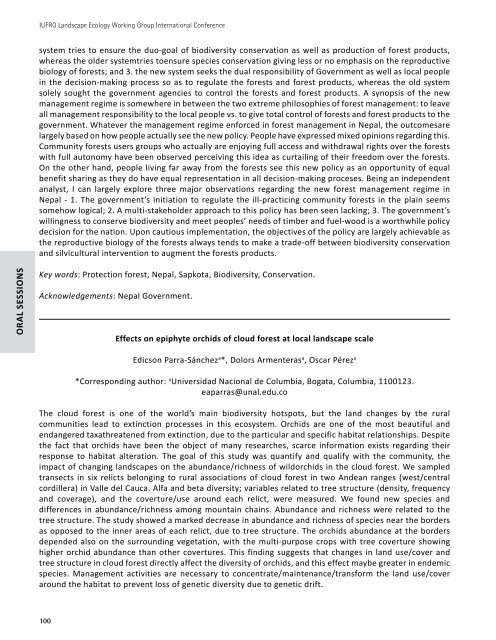IUFRO-LIBRO
IUFRO-LIBRO
IUFRO-LIBRO
You also want an ePaper? Increase the reach of your titles
YUMPU automatically turns print PDFs into web optimized ePapers that Google loves.
ORAL SESSIOnS<br />
<strong>IUFRO</strong> Landscape Ecology Working Group International Conference<br />
system tries to ensure the duo‐goal of biodiversity conservation as well as production of forest products,<br />
whereas the older systemtries toensure species conservation giving less or no emphasis on the reproductive<br />
biology of forests; and 3. the new system seeks the dual responsibility of Government as well as local people<br />
in the decision‐making process so as to regulate the forests and forest products, whereas the old system<br />
solely sought the government agencies to control the forests and forest products. A synopsis of the new<br />
management regime is somewhere in between the two extreme philosophies of forest management: to leave<br />
all management responsibility to the local people vs. to give total control of forests and forest products to the<br />
government. Whatever the management regime enforced in forest management in Nepal, the outcomesare<br />
largely based on how people actually see the new policy. People have expressed mixed opinions regarding this.<br />
Community forests users groups who actually are enjoying full access and withdrawal rights over the forests<br />
with full autonomy have been observed perceiving this idea as curtailing of their freedom over the forests.<br />
On the other hand, people living far away from the forests see this new policy as an opportunity of equal<br />
benefit sharing as they do have equal representation in all decision‐making proceses. Being an independent<br />
analyst, I can largely explore three major observations regarding the new forest management regime in<br />
Nepal ‐ 1. The government’s initiation to regulate the ill‐practicing community forests in the plain seems<br />
somehow logical; 2. A multi‐stakeholder approach to this policy has been seen lacking; 3. The government’s<br />
willingness to conserve biodiversity and meet peoples’ needs of timber and fuel‐wood is a worthwhile policy<br />
decision for the nation. Upon cautious implementation, the objectives of the policy are largely achievable as<br />
the reproductive biology of the forests always tends to make a trade‐off between biodiversity conservation<br />
and silvicultural intervention to augment the forests products.<br />
Key words: Protection forest, Nepal, Sapkota, Biodiversity, Conservation.<br />
Acknowledgements: Nepal Government.<br />
100<br />
Effects on epiphyte orchids of cloud forest at local landscape scale<br />
Edicson Parra‐Sánchez a *, Dolors Armenteras a , Oscar Pérez a<br />
*Corresponding author: a Universidad Nacional de Columbia, Bogata, Columbia, 1100123.<br />
eaparras@unal.edu.co<br />
The cloud forest is one of the world’s main biodiversity hotspots, but the land changes by the rural<br />
communities lead to extinction processes in this ecosystem. Orchids are one of the most beautiful and<br />
endangered taxathreatened from extinction, due to the particular and specific habitat relationships. Despite<br />
the fact that orchids have been the object of many researches, scarce information exists regarding their<br />
response to habitat alteration. The goal of this study was quantify and qualify with the community, the<br />
impact of changing landscapes on the abundance/richness of wildorchids in the cloud forest. We sampled<br />
transects in six relicts belonging to rural associations of cloud forest in two Andean ranges (west/central<br />
cordillera) in Valle del Cauca. Alfa and beta diversity; variables related to tree structure (density, frequency<br />
and coverage), and the coverture/use around each relict, were measured. We found new species and<br />
differences in abundance/richness among mountain chains. Abundance and richness were related to the<br />
tree structure. The study showed a marked decrease in abundance and richness of species near the borders<br />
as opposed to the inner areas of each relict, due to tree structure. The orchids abundance at the borders<br />
depended also on the surrounding vegetation, with the multi‐purpose crops with tree coverture showing<br />
higher orchid abundance than other covertures. This finding suggests that changes in land use/cover and<br />
tree structure in cloud forest directly affect the diversity of orchids, and this effect maybe greater in endemic<br />
species. Management activities are necessary to concentrate/maintenance/transform the land use/cover<br />
around the habitat to prevent loss of genetic diversity due to genetic drift.


